Hosted by site sponsor WebMate.
iPhone Q&A
Published September 30, 2025
All Apple Q&As >> iPhone Q&A (Home)
To be notified of new Q&As, sign up for EveryMac.com's bimonthly email list.
What are the major differences between the iPhone 15 (2023), iPhone 16 (2024), and iPhone 17 (2025)? Aren't these iPhone models basically the same?
Please note that the iPhone 15 has been discontinued. Apple continues to sell the iPhone 16 and iPhone 17 as new. This Q&A can be quite helpful for anyone considering one of these models whether new or used.
There are a dozen different variants of the iPhone 15, iPhone 16, and iPhone 17, but this EveryiPhone.com Q&A primarily covers collective differences to make it easy to figure out which device is best for you.
First, it definitely would be an overstatement to say that the iPhone 15, iPhone 16, and iPhone 17 models are the same. These models have some common aspects, but also some substantial differences. The differences between these lines are not obvious, though, and require detailed attention, accordingly.
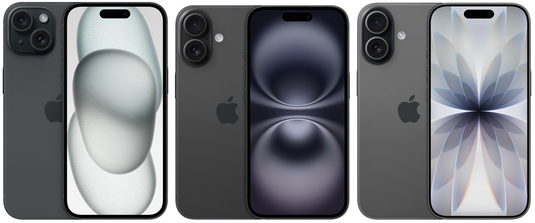
Photo Credit: Apple, Inc. (Left to Right: iPhone 15, 16, 17; Black Options)
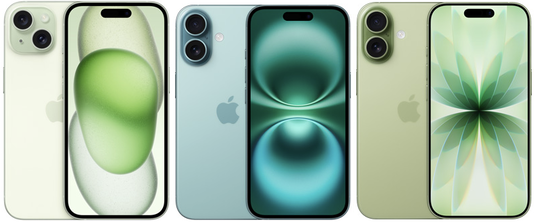
Photo Credit: Apple, Inc. (Left to Right: iPhone 15, 16, 17; Green Options)
In very basic terms, although there are specific part differences, the iPhone 15 and iPhone 16 models tend to have internals that have much in common with the iPhone "Pro" models from the year before and externals and feature support that are closer to improvements from the previous year's entry-level option. This pattern doesn't quite hold for the iPhone 17, and if anything, it makes a detailed analysis between the three lines particularly worthwhile.
External Design & Functionality Differences
The iPhone 15, iPhone 16, and iPhone 17 models all use a rounded rectangle design with a glass front and back and an aluminum case with flat edges. All three models have a "Ceramic Shield" over the display for durability -- the iPhone 17 has a "Ceramic 2 Shield" said to provide "3x better" scratch resistance than the original -- and are waterproof to the IP68 standard for up to 30 minutes of water exposure to a depth of six meters. All three support the "Dynamic Island" interface feature at the top of the display, as well.
All three models also have stereo speakers, a USB-C port, magnetic "MagSafe" charging capability, and Face ID authentication. Many models sold outside of the United States also have a side-mounted access panel for physical SIM access (US models from all three lines only support eSIM as do iPhone 17 models sold in Canada, Mexico, Japan, Saudi Arabia, and a handful of other countries).
Other capabilities and features are a bit different. The iPhone 15 has a simple ring/silent toggle switch whereas the iPhone 16 and iPhone 17 have a physical programmable "Action" button and a physical "Camera Control" button -- essentially a modern take on a camera shutter release -- to make photography potentially easier.
The iPhone 17 display is a bit larger and substantially better quality than its predecessors.
The iPhone 15 and iPhone 16 have a 6.1" OLED "Super Retina XDR" display (2556x1179, 460 ppi, 1000 nits max brightness, 1600 nits peak brightness HDR, 2000 nits peak brightness outdoors). The iPhone 16 also adds a 1 nit minimum brightness capability for potentially reduced eyestrain.
The iPhone 17, on the other hand, has an "Always-On" 6.3" OLED "Super Retina XDR" display with ProMotion (2622x1206, 460 ppi, 1000 nits max brightness, 1600 nits peak brightness HDR; 3000 nits peak brightness outdoors; 1 nit minimum brightness). It also has a 2,000,000:1 typical contrast ratio and adaptive refresh rates up to 120 Hz.
These differences, along with the very similar dimensions and weight, are below:
 iPhone 15 |
 iPhone 16 |
 iPhone 17 |
|
| Material: | Aluminum/Glass | Aluminum/Glass | Aluminum/Glass |
| Port: | USB-C | USB-C | USB-C |
| Button: | Ring/Silent | Action | Action |
| Camera Control: | No | Yes | Yes |
| Display: | 6.1" OLED | 6.1" OLED | 6.3" OLED |
| Resolution: | 2556x1179 | 2556x1179 | 2622x1206 |
| Always On: | No | No | Yes |
| ProMotion: | No | No | Yes |
| Max Brightness: | 1000 nits | 1000 nits | 1000 nits |
| HDR Brightness: | 1600 nits | 1600 nits | 1600 nits |
| Outdoors: | 2000 nits | 2000 nits | 3000 nits |
| Min Brightness: | N/A | 1 nit | 1 nit |
| Dynamic Island: | Yes | Yes | Yes |
| Speakers: | Stereo | Stereo | Stereo |
| Inductive: | Yes (Qi/Qi2) | Yes (Qi/Qi2) | Yes (Qi/Qi2) |
| MagSafe: | Yes | Yes | Yes |
| Dimensions (In): | 5.81 x 2.82 x 0.31 | 5.81 x 2.82 x 0.31 | 5.89 x 2.81 x 0.31 |
| Weight: | 6.02 oz. (171 g) | 6.0 oz. (170 g) | 6.24 oz. (177 g) |
Housing Color Differences
The iPhone 15, iPhone 16, and iPhone 17 all have a variety of colors options, but except for black, which is roughly the same, they are not the same colors.
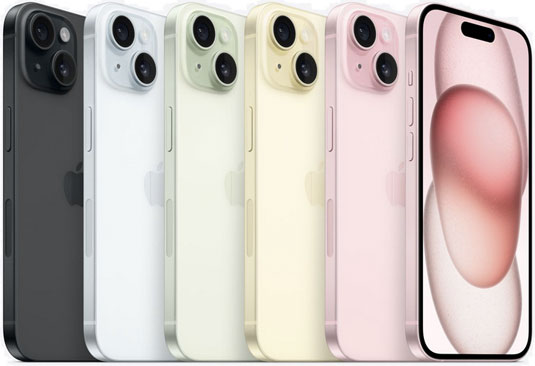
Photo Credit: Apple, Inc. (iPhone 15 Colors)
The iPhone 15 (above) is offered in five colors (left to right) -- Black in addition to muted, pastel shades of Blue, Green, Yellow, and Pink.
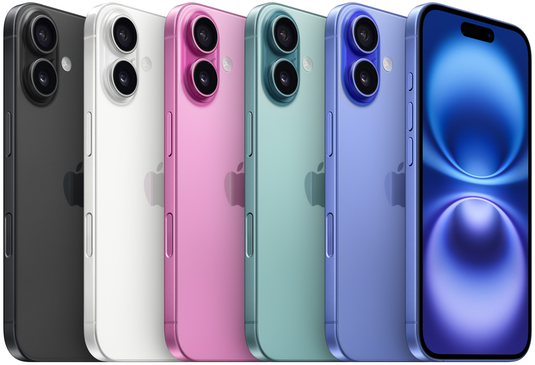
Photo Credit: Apple, Inc. (iPhone 16 Colors)
The iPhone 16 (above) is offered in five different colors (left to right) -- Black and White as well as vibrant shades of Pink, Teal, and "Ultramarine" (Blue).
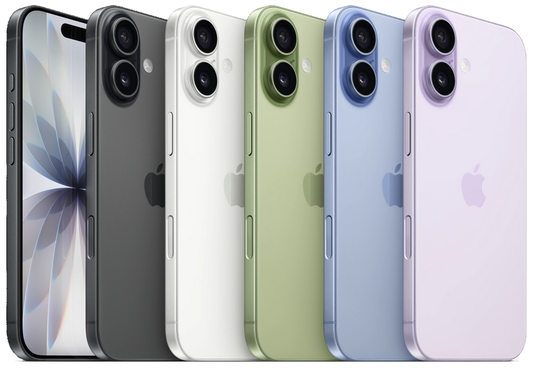
Photo Credit: Apple, Inc. (iPhone 17 Colors)
Finally, the iPhone 17 (above) has five subdued color options -- Black, White, Sage (Green), "Mist Blue", and Lavender (left to right).
As you can see, the colors are quite different between lines. Black always is a safe, albeit maybe a little boring, choice. Personally, we prefer the more subdued colors provided by the iPhone 17, but some people really love the more vibrant choices provided by the iPhone 16. Color definitely is a personal choice.
Camera Differences
The rear cameras in the iPhone 15, iPhone 16, and iPhone 17 are a notable point of differentiation.
Front Cameras
The front-facing camera on all of these models -- which Apple calls "TrueDepth" on the iPhone 15 and iPhone 16 and "Center Stage" on the iPhone 17 -- support Face ID authentication, augmented reality (AR), still photos, and video, but the software and hardware is more advanced in the iPhone 17.
Most notably, the iPhone 17 "Center Stage" functionality automatically pans and zooms to keep subjects in frame during selfies and videocalls alike. The iPhone 17 camera has a higher megapixel sensor, as well:
 iPhone 15 |
 iPhone 16 |
 iPhone 17 |
|
| Megapixels: | 12 MP | 12 MP | 18 MP |
| Aperture: | f/1.9 | f/1.9 | f/1.9 |
| Video: | 4K | 4K | 4K |
Rear Cameras
The rear cameras in the iPhone 15, iPhone 16, and iPhone 17 all shoot 4K video and stills and have dual cameras, but there is a significant jump in capability between the iPhone 16 and iPhone 17:
 iPhone 15 |
 iPhone 16 |
 iPhone 17 |
|
| Megapixels: | 48 MP/12 MP | 48 MP/12 MP | 48 MP/48 MP |
| Main: | f/1.6 | f/1.6 | f/1.6 |
| Ultra Wide: | f/2.4 | f/2.2 | f/2.2 |
| Telephoto: | None | None | None |
| Dolby Vision: | 4K | 4K | 4K |
| Digital Zoom: | 2x-10x | 2x-10x | 2x-10x |
By combining an image from both cameras, these models all emulate a 2x optical zoom. Apple advertises that the Fusion Main camera in the iPhone 17 also "enables" 12 megapixel "optical-quality" 2x Telephoto (52 mm focal length, f/1.6 aperture).
The iPhone 16 and iPhone 17 provide support for macro photography and more advanced photographic styles, too.
Identification Differences
The iPhone 15, iPhone 16, and iPhone 17 are easy to mix up with each other and other iPhone models, as well. It is not possible to visually identify specific iPhone 15, iPhone 16, or iPhone 17 models, either.
Accordingly, one relatively simple way to uniquely identify the exact iPhone 15, iPhone 16, and iPhone 17 is by the Model Number listed on the cardboard shipping box and within the iOS "Settings" app as well as other locations.
Consequently, for the purpose of this Q&A, it is sufficient to note that the following model numbers refer to these iPhone devices:
iPhone Model |
Model No |
EveryiPhone.com's Ultimate iLookup feature also can precisely identify these iPhone models by Order Number (referred to as "Model" within the iOS "Settings" app under General > About).
Battery Life Differences
The iPhone 15, iPhone 16, and iPhone 17 all have excellent battery life, but the iPhone 17 is the best of the three:
 iPhone 15 |
 iPhone 16 |
 iPhone 17 |
|
| Streamed Video: | 16 Hours | 18 Hours | 27 Hours |
| Video Playback: | 20 Hours | 22 Hours | 30 Hours |
| Audio Playback: | 80 Hours | 80 Hours | -- |
Apple no longer provides an estimate of audio playback time for the iPhone 17, but it is a safe bet that it is longer than the earlier models, as well.
Wireless Connectivity & Data Differences
There are specific 5G band differences for different iPhone 15, iPhone 16, and iPhone 17 models depending on the location sold, but they all support fast 5G connectivity.
All three models also support dual SIMs, but specifics vary. Models sold in the United States support dual eSIMs and models sold in China support dual physical Nano SIM. Models sold just about everywhere else have dual eSIMs and a single physical Nano SIM.
The iPhone 16 and iPhone 17 additionally support the newer Wi-Fi 7 (802.11be) standard compared to Wi-Fi 6 for the iPhone 15.
Internal Differences
The iPhone 15, iPhone 16, and iPhone 17 have significantly different internal specs:
 iPhone 15 |
 iPhone 16 |
 iPhone 17 |
|
| Clockspeed: | 3.5 GHz | 4.0 GHz | 4.25 GHz |
| Processor: | Apple A16 Bionic | Apple A18 | Apple A19 |
| CPU: | 6 Cores | 6 Cores | 6 Cores |
| GPU: | 5 Cores | 5 Cores | 5 Cores |
| RAM: | 6 GB | 8 GB | 8 GB |
| Storage: | 128/256/512 GB | 128/256/512 GB | 256/512 GB |
In benchmark tests, the iPhone 16 is about 29% faster than the iPhone 15 and the iPhone 17 is about 13% to 17% faster than the iPhone 16. The more substantial jump in performance from the iPhone 15 to the iPhone 16, no doubt, is because of the increase in RAM.
iOS Support Differences
The iPhone 15 originally shipped with iOS 17, the iPhone 16 with iOS 18, and the iPhone 17 with iOS 26.
All three support iOS 26, the current version of the iOS, but the iPhone 15 does not support the Apple Intelligence (AI) feature whereas the iPhone 16 and iPhone 17 do.
It's always hard to know for sure whether this restriction is an artificial limitation to encourage new -- and/or more expensive -- hardware purchases, but if it is a genuine technical requirement, the extra RAM in the newer iPhone models may be the necessary difference.
iPhone 15, iPhone 16 & iPhone 17 Comparison Chart
These differences as well as other details and pricing information is summarized below:
 iPhone 15 |
 iPhone 16 |
 iPhone 17 |
|
| Introduced: | Sep 2023 | Sep 2024 | Sep 2025 |
| Discontinued: | Sep 2025 | Current | Current |
| Processor: | 3.5 GHz A16 | 4.0 GHz A18 | 4.25 GHz A19 |
| RAM: | 6 GB | 8 GB | 8 GB |
| Storage: | 128/256/512 GB | 128/256/512 GB | 256/512 GB |
| Battery Life: | 16-20 Hours | 18-22 Hours | 27-30 Hours |
| Display: | 6.1" OLED | 6.1" OLED | 6.3" OLED |
| Resolution: | 2556x1179 | 2556x1179 | 2622x1206 |
| Always On: | No | No | Yes |
| ProMotion: | No | No | Yes |
| Front Camera: | 12 MP | 12 MP | 18 MP |
| Rear Camera: | 2 (48/12 MP) | 2 (48/12 MP) | 2 (48/48 MP) |
| Material: | Alum/Glass | Alum/Glass | Alum/Glass |
| Dynamic Island: | Yes | Yes | Yes |
| Action Button: | No | Yes | Yes |
| Camera Control: | No | Yes | Yes |
| Port: | USB-C | USB-C | USB-C |
| MagSafe: | Yes | Yes | Yes |
| SIM Card: | Nano/eSIM x2 | Nano/eSIM x2 | Nano/eSIM x2 |
| 5G Cellular: | Yes | Yes | Yes |
| Wi-Fi: | 6 | 7 | 7 |
| Thread: | No | Yes | Yes |
| Original iOS: | iOS 17 | iOS 18 | iOS 26 |
| Maximum iOS: | iOS 26 | iOS 26 | iOS 26 |
| Apple AI: | No | Yes | Yes |
| Original* (US): | US$799 US$899 US$1099 |
US$799 US$899 US$1099 |
US$799 US$999 |
| Current* (US): | Used Only | US$699 | US$799 US$999 |
* Note that these prices are for devices unlocked and paid in full upfront. On September 9, 2025, Apple discontinued the iPhone 15 as well as the 256 GB and 512 GB configuration options of the iPhone 16 and cut the price of the remaining 128 GB configuration to US$699.
For pricing in dozens of countries, see the "Global Prices" on the specs page for each iPhone as well as the "By Global Original Prices" section of EveryiPhone.com.
So, which is for me? Should I buy an iPhone 15, iPhone 16, or iPhone 17?
Just between the iPhone 15, iPhone 16, and iPhone 17 (and ignoring other models), the newest iPhone 17 clearly is the best of the three.
When purchased new, the iPhone 17 is only US$100 more than the iPhone 16, but this gets you (1) a much better quality, slightly larger, and more durable display, (2) twice the storage capacity (256 GB instead of 128 GB), (3) better battery life, (4) faster performance, and (5) both better front and rear cameras. Clearly, this is a lot of extra value for US$100 and the iPhone 17 is the best choice, accordingly.
On the used market, both the iPhone 15 and iPhone 16 will cost less and definitely remain well worth consideration for those on a budget, but note that the iPhone 15 does not support Apple Intelligence (AI) capability, should that be important to you.
Even if Apple Intelligence is not of critical importance to you, compared to the iPhone 15, the iPhone 16 also is (1) significantly faster and (2) has more RAM. This extra RAM in particular likely will mean that it will support the current version of the iOS longer and probably would end up being cheaper on an annual usage basis for someone who takes good care of their hardware if purchased today. The iPhone 16 also has (3) a bit better battery life and (4) faster Wi-Fi 7 support.
Of course, for those on a budget, any number of other iPhone models will be cheaper on the used market and are worth considering, too.
In the US, site sponsor Other World Computing sells used and refurbished iPhone models with free shipping. If you need to sell an iPhone, A+ BBB-rated Cash for Your Mac and GoRoostr will buy your older iPhone with an instant quote and prompt payment.
Please also see EveryiPhone.com's Ultimate iComparison feature to dynamically compare any iPhone model to any other iPod, iPhone, or iPad.
Permalink | Report an Error/Typo | Sign Up for Site Update Notices
<< iPhone Q&A (Main) | All Apple Q&As
Established in 1996, EveryMac.com has been created by experts with decades of experience with Apple hardware. EveryMac.com includes, and always has included, original research incorporating detailed, hands-on inspection of packaging, computers, and devices as well as extensive real-world use. All information is provided in good faith, but no website or person is perfect. Accordingly, EveryMac.com is provided "as is" without warranty of any kind whatsoever. EveryMac.com, and the authors thereof, shall not be held responsible or liable, under any circumstances, for any damages resulting from the use or inability to use the information within. For complete disclaimer and copyright information please read and understand the Terms of Use and the Privacy Policy before using EveryMac.com. Copying, scraping, or use of any content without expressed permission is not allowed, although links to any page are welcomed and appreciated.
